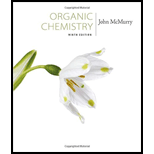
Study Guide with Student Solutions Manual for McMurry's Organic Chemistry, 9th
9th Edition
ISBN: 9781305082144
Author: John E. McMurry
Publisher: Cengage Learning
expand_more
expand_more
format_list_bulleted
Concept explainers
Textbook Question
Chapter 16.SE, Problem 38MP
Benzenediazonium carboxylate decomposes when heated to yield N2, CO2, and a reactive substance that can't be isolated. When benzene- diazonium carboxylate is heated in the presence of furan, the following reaction is observed:

What intermediate is involved in this reaction? Propose a mechanism for its formation.
Expert Solution & Answer
Trending nowThis is a popular solution!

Students have asked these similar questions
please help with hw
help me solve this hw
help me solve this hw
Chapter 16 Solutions
Study Guide with Student Solutions Manual for McMurry's Organic Chemistry, 9th
Ch. 16.1 - Prob. 1PCh. 16.2 - Propose a mechanism for the electrophilic...Ch. 16.2 - How many products might be formed on chlorination...Ch. 16.2 - When benzene is treated with D2SŪ4. deuterium...Ch. 16.3 - Prob. 5PCh. 16.3 - What is the major monosubstitution product from...Ch. 16.3 - Identify the carboxylic acid chloride that might...Ch. 16.4 - Rank the compounds in each of the following groups...Ch. 16.4 - Predict the major products of the following...Ch. 16.4 - Prob. 10P
Ch. 16.4 - Prob. 11PCh. 16.4 - Acetanilide is less reactive than aniline toward...Ch. 16.4 - Prob. 13PCh. 16.5 - At what position would you expect electrophilic...Ch. 16.5 - Show the major product(s) from reaction of the...Ch. 16.6 - The herbicide oxyfluorfen can be prepared by...Ch. 16.7 - Treatment of p-bromotoluene with NaOH at 300°C...Ch. 16.8 - Prob. 18PCh. 16.8 - Prob. 19PCh. 16.8 - Prob. 20PCh. 16.9 - Prob. 21PCh. 16.10 - Prob. 22PCh. 16.10 - Prob. 23PCh. 16.SE - Prob. 24VCCh. 16.SE - The following molecular model of a...Ch. 16.SE - Prob. 26VCCh. 16.SE - Prob. 27VCCh. 16.SE - Aromatic iodination can be carried out with a...Ch. 16.SE - Prob. 29MPCh. 16.SE - The carbocation electrophile in a Friede1-Crafts...Ch. 16.SE - Prob. 31MPCh. 16.SE - The nitroso group, —N=O, is one of the few...Ch. 16.SE - Triphenylmethane can be prepared by reaction of...Ch. 16.SE - Using resonance structures of the intermediates,...Ch. 16.SE - Benzene and alkyl -substituted benzenes can be...Ch. 16.SE - Prob. 36MPCh. 16.SE - Hexachlorophene, a substance used in the...Ch. 16.SE - Benzenediazonium carboxylate decomposes when...Ch. 16.SE - 4-Chloropyridine undergoes reaction with...Ch. 16.SE - Propose a mechanism to account for the following...Ch. 16.SE - In the Gatterman-Kochreaction, a formyl group...Ch. 16.SE - Treatment of p-tert-butylphenol with a strong acid...Ch. 16.SE - Benzyl bromide is converted into benzaldehyde by...Ch. 16.SE - Prob. 44MPCh. 16.SE - Prob. 45MPCh. 16.SE - Prob. 46APCh. 16.SE - Prob. 47APCh. 16.SE - Prob. 48APCh. 16.SE - Predict the major monoalkylation products you...Ch. 16.SE - Name and draw the major product(s) of...Ch. 16.SE - Prob. 51APCh. 16.SE - Prob. 52APCh. 16.SE - What product(s) would you expect to obtain from...Ch. 16.SE - Prob. 54APCh. 16.SE - How would you synthesize the following substances...Ch. 16.SE - Prob. 56APCh. 16.SE - Prob. 57APCh. 16.SE - Prob. 58APCh. 16.SE - Prob. 59APCh. 16.SE - Prob. 60APCh. 16.SE - Prob. 61APCh. 16.SE - Prob. 62APCh. 16.SE - Prob. 63APCh. 16.SE - How would you synthesize the following substances...Ch. 16.SE - Prob. 65APCh. 16.SE - Prob. 66APCh. 16.SE - Draw resonance structures of the intermediate...Ch. 16.SE - Prob. 68APCh. 16.SE - p-Bromotoluene reacts with potassium amide to give...Ch. 16.SE - Prob. 70APCh. 16.SE - Prob. 71APCh. 16.SE - Prob. 72APCh. 16.SE - Use your knowledge of directing effects, along...Ch. 16.SE - Identify the reagents represented by the letters...Ch. 16.SE - Phenols (ArOH) are relatively acidic, and the...Ch. 16.SE - Prob. 76APCh. 16.SE - Prob. 77APCh. 16.SE - Melamine, used as a fire retardant and a component...
Knowledge Booster
Learn more about
Need a deep-dive on the concept behind this application? Look no further. Learn more about this topic, chemistry and related others by exploring similar questions and additional content below.Similar questions
- Reason whether it is possible to determine changes in the Galvani potential difference at the metal-solution interface.arrow_forwardObtain the standard potential at 25°C of the Cu* I Cu | Pt electrode from the standard potentials E° Cu²+/Cu = 0.341 V and E Cu²+ /Cu+ = 0.153 V.arrow_forwardIn electrochemistry, briefly describe the Galvani potential, the Volta potential, and the surface potential. Differentiate between them.arrow_forward
arrow_back_ios
SEE MORE QUESTIONS
arrow_forward_ios
Recommended textbooks for you

 Organic ChemistryChemistryISBN:9781305580350Author:William H. Brown, Brent L. Iverson, Eric Anslyn, Christopher S. FootePublisher:Cengage Learning
Organic ChemistryChemistryISBN:9781305580350Author:William H. Brown, Brent L. Iverson, Eric Anslyn, Christopher S. FootePublisher:Cengage Learning EBK A SMALL SCALE APPROACH TO ORGANIC LChemistryISBN:9781305446021Author:LampmanPublisher:CENGAGE LEARNING - CONSIGNMENT
EBK A SMALL SCALE APPROACH TO ORGANIC LChemistryISBN:9781305446021Author:LampmanPublisher:CENGAGE LEARNING - CONSIGNMENT


Organic Chemistry
Chemistry
ISBN:9781305580350
Author:William H. Brown, Brent L. Iverson, Eric Anslyn, Christopher S. Foote
Publisher:Cengage Learning

EBK A SMALL SCALE APPROACH TO ORGANIC L
Chemistry
ISBN:9781305446021
Author:Lampman
Publisher:CENGAGE LEARNING - CONSIGNMENT
Coenzymes and cofactors; Author: CH15 SWAYAM Prabha IIT Madras;https://www.youtube.com/watch?v=bubY2Nm7hVM;License: Standard YouTube License, CC-BY
Aromaticity and Huckel's Rule; Author: Professor Dave Explains;https://www.youtube.com/watch?v=7-BguH4_WBQ;License: Standard Youtube License